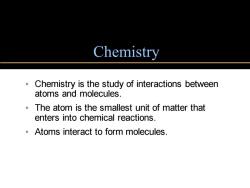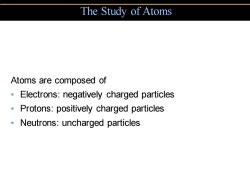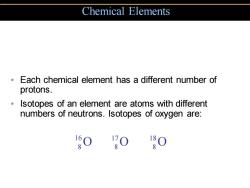《微生物学 Microbiology》课程PPT教学课件(英文版)chemical principles 1/2

Chapter 2,part A Chemical Principles
Copyright © 2004 Pearson Education, Inc., publishing as Benjamin Cummings B.E Pruitt & Jane J. Stein Chapter 2, part A Chemical Principles

Chemistry Chemistry is the study of interactions between atoms and molecules. The atom is the smallest unit of matter that enters into chemical reactions. Atoms interact to form molecules
Chemistry • Chemistry is the study of interactions between atoms and molecules. • The atom is the smallest unit of matter that enters into chemical reactions. • Atoms interact to form molecules

The Study of Atoms Atoms are composed of Electrons:negatively charged particles Protons:positively charged particles Neutrons:uncharged particles
Atoms are composed of • Electrons: negatively charged particles • Protons: positively charged particles • Neutrons: uncharged particles The Study of Atoms

The Study of Atoms Protons and neutrons are in the nucleus. Electrons move around the nucleus. Electron shells Proton (p*) Nucleus Neutron(n) Electron(e)- Figure 2.1
• Protons and neutrons are in the nucleus. • Electrons move around the nucleus. The Study of Atoms Figure 2.1

Chemical Elements Each chemical element has a different number of protons. Isotopes of an element are atoms with different numbers of neutrons.Isotopes of oxygen are: O 0
• Each chemical element has a different number of protons. • Isotopes of an element are atoms with different numbers of neutrons. Isotopes of oxygen are: Chemical Elements 16 8O 17 8O 18 8O

TABLE 2.1 The Elements of Life* Atomic Approximate Element Symbol Number Atomic Weight Hydrogen H 1 1 Carbon C 6 12 Nitrogen N > 14 Oxygen 0 0 16 Sodium Na 11 23 Magnesium Mg 12 24 Phosphorus P 15 31 Sulfur s 16 32 Chlorine CI 17 35 Potassium K 19 39 Calcium Ca 20 40 Iron Fe 26 56 lodine 53 127 *Hydrogen,carbon,nitrogen,and oxygen are the most abundant chemical elements in living organisms. Table 2.1
Table 2.1

Electronic Configurations Electrons are arranged in electron shells corresponding to different energy levels
• Electrons are arranged in electron shells corresponding to different energy levels. Electronic Configurations

Electronic Configurations TABLE 2.2 Electronic Configurations for the Atoms of Some Elements Found in Living Organisms Number First Second Third of Valence Number Maximum Electron Electron Electron (Outermost) of Unfilled Number of Element Shell Shell Shell Diagram Shell Electrons Spaces Bonds Formed Hydrogen 1 1 88 Carbon 4 00 Nitrogen 2 0 00 oo Oxygen 2 electron unfilled space Key:atomic nucleus Table 2.2.1
Electronic Configurations Table 2.2.1

Electronic Configurations TABLE 2.2 Electronic Configurations for the Atoms of Some Elements Found in Living Organisms(continued) Number First Second Third of Valence Number Maximum Electron Electron Electron (Outermost) of Unfilled Number of Element Shell Shell Shell Diagram Shell Electrons Spaces Bonds Formed Magnesium 2 2 2 Phosphorus 2 Sulfur 2 6 2 electron Cunfilled space Key:atomic nucleus Table 2.2.2
Electronic Configurations Table 2.2.2

How Atoms Form Molecules:Chemical Bonds Atoms combine to complete the outermost shell. The number of missing or extra electrons in this shell is the valence
• Atoms combine to complete the outermost shell. • The number of missing or extra electrons in this shell is the valence. How Atoms Form Molecules: Chemical Bonds
按次数下载不扣除下载券;
注册用户24小时内重复下载只扣除一次;
顺序:VIP每日次数-->可用次数-->下载券;
- 《微生物学 Microbiology》课程PPT教学课件(英文版)biotechnology and recombinant DNA 2/2.ppt
- 《微生物学 Microbiology》课程PPT教学课件(英文版)biotechnology and recombinant DNA 1/2.ppt
- 《微生物学 Microbiology》课程PPT教学课件(英文版)applied and industrial microbiology.ppt
- 《微生物学 Microbiology》课程PPT教学课件(英文版)antimicrobial drugs 2/2.ppt
- 《微生物学 Microbiology》课程PPT教学课件(英文版)antimicrobial drugs 1/2.ppt
- 云南农业大学:《微生物学》课程教学资源(PPT课件)第四章 微生物的生长和环境条件.ppt
- 云南农业大学:《微生物学》课程教学资源(PPT课件)第六章 真核微生物.ppt
- 云南农业大学:《微生物学》课程教学资源(PPT课件)第八章 微生物的生态.ppt
- 云南农业大学:《微生物学》课程教学资源(PPT课件)第五章 原核生物.ppt
- 云南农业大学:《微生物学》课程教学资源(PPT课件)第三章 细菌的遗传和变异.ppt
- 云南农业大学:《微生物学》课程教学资源(PPT课件)第七章 病毒.ppt
- 云南农业大学:《微生物学》课程教学资源(PPT课件)绪论(主讲:刘雅婷).ppt
- 云南农业大学:《微生物学》课程教学资源(PPT课件)第二章 微生物的营养和代谢.ppt
- 云南农业大学:《微生物学》课程教学资源(PPT课件)第一章 微生物的细胞.ppt
- 《微生物学》课程教学资源(PPT课件)第八章 微生物生态.ppt
- 《微生物学》课程教学资源(PPT课件)第九章 传染与免疫.ppt
- 《微生物学》课程教学资源(PPT课件)第七章 微生物的遗传变异和育种.ppt
- 《微生物学》课程教学资源(PPT课件)第四、五章 微生物的营养与培养基.ppt
- 《微生物学》课程教学资源(PPT课件)第六章 微生物的生长繁殖及其控制.ppt
- 《微生物学》课程教学资源(PPT课件)第二章 真核微生物.ppt
- 《微生物学 Microbiology》课程PPT教学课件(英文版)chemical principles 2/2.ppt
- 《微生物学 Microbiology》课程PPT教学课件(英文版)classification of microrganisms 1/2.ppt
- 《微生物学 Microbiology》课程PPT教学课件(英文版)classification of microrganisms 2/2.ppt
- 《微生物学 Microbiology》课程PPT教学课件(英文版)disorders associated with the immune system 1/2.ppt
- 《微生物学 Microbiology》课程PPT教学课件(英文版)disorders associated with the immune system 2/2.ppt
- 《微生物学 Microbiology》课程PPT教学课件(英文版)domains bacteria archaea 1/5.ppt
- 《微生物学 Microbiology》课程PPT教学课件(英文版)domains bacteria archaea 2/5.ppt
- 《微生物学 Microbiology》课程PPT教学课件(英文版)domains bacteria archaea 3/5.ppt
- 《微生物学 Microbiology》课程PPT教学课件(英文版)domains bacteria archaea 4/5.ppt
- 《微生物学 Microbiology》课程PPT教学课件(英文版)domains bacteria archaea 5/5.ppt
- 《微生物学 Microbiology》课程PPT教学课件(英文版)environmental microbiology 1/3.ppt
- 《微生物学 Microbiology》课程PPT教学课件(英文版)environmental microbiology 2/3.ppt
- 《微生物学 Microbiology》课程PPT教学课件(英文版)environmental microbiology 3/3.ppt
- 《微生物学 Microbiology》课程PPT教学课件(英文版)functional anatomy of prokaryotic and eukaryotic cells 1/2.ppt
- 《微生物学 Microbiology》课程PPT教学课件(英文版)functional anatomy of prokaryotic and eukaryotic cells 2/2.ppt
- 《微生物学 Microbiology》课程PPT教学课件(英文版)fungi algae protozoa and helminths 1/4.ppt
- 《微生物学 Microbiology》课程PPT教学课件(英文版)fungi algae protozoa and helminths 2/4.ppt
- 《微生物学 Microbiology》课程PPT教学课件(英文版)fungi algae protozoa and helminths 3/4.ppt
- 《微生物学 Microbiology》课程PPT教学课件(英文版)fungi algae protozoa and helminths 4/4.ppt
- 《微生物学 Microbiology》课程PPT教学课件(英文版)microbial diseases of digestive system 1/3.ppt
